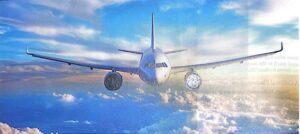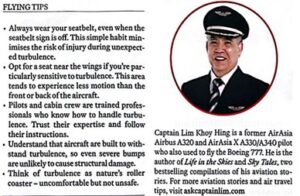
UNDERSTANDING TURBULENCE
Turbulence in the skies is a much-dreaded phenomenon when flying. But what exactly is it and how does one ride it out safely?
Captain Lim Khoy Hing explains.
Turbulence is a sudden, unsteady movement of air. To simplify it, imagine driving a car on a bumpy road. Turbulence is the aerial equivalent of that and is caused by various factors when flying in an aircraft. This can include jet streams, mountains near your flight path, weather fronts and thunderstorms.
Narrow air currents travel up to 200 miles per hour at high altitudes. When planes intersect with these jet streams, the sudden change in wind speed can cause turbulence.
Additionally, air flowing over mountains creates waves in the atmosphere.
These waves can extend high into the sky and affect aircraft passing through them.
Another form of turbulence called wake turbulence occurs when planes fly too close to each other. One plane’s wingtips can create vortices in the air that can subsequently agitate the other aircraft.
But thunderstorms are perhaps the biggest culprits. They create strong updrafts and downdrafts, which can be quite unsettling when encountered mid-flight.
For instance, in 2024, an incident involving a commercial airliner over the Bay of Bengal resulted in several injuries due to severe turbulence caused by inclement weather.
Turbulence Intensity
There are four levels of turbulence intensity – light, moderate, severe and extreme. During light turbulence, small, unsecured objects may be dislodged, while in moderate turbulence, guests may experience repeated bumps in the flight.
When an aircraft experiences severe turbulence, guests may be violently forced against their seatbelts. In extreme turbulence, the aircraft may be tossed about, possibly causing some structural damage
Severe and extreme turbulence is rare as pilots generally avoid it. However, clear-air turbulence, as the name suggests, may occur and is harder to detect because it cannot be spotted on radar.
Is Turbulence Dangerous?
The short answer – rarely. Modero aircraft are designed to withstand even the roughest turbulence. Pilots are highly trained to handle these situations and are constantly in touch with air traffic control to navigate around turbulent areas when possible.
While it might feel intense, turbulence is more inconvenient than dangerous. The structural integrity of the aircraft is not at risk. Injuries related to turbulence usually occur only when passengers are not wearing seatbelts. So, always buckle up, even when the seatbelt signs are off.

How Pilots Navigate Turbulence
Pilots are trained to deal with air turbulence in a variety of ways. Before take-off, pilots review weather conditions along the flight path and plan their routes accordingly to avoid potential turbulence. Once the plane is in the air, pilots monitor the weather radar on board the aircraft to detect storm systems and possible turbulence en route. This allows them to navigate the aircraft around a storm. Pilots also receive updates from Air Traffic Control about turbulence reported by other nearby aircraft.
For some, turbulence is more fascinating than frightening. It’s a reminder of the powerful forces of nature and how modern aviation navigates through them.
Next time you feel a bump mid-flight, remember it’s a normal part of air trav-el. With knowledge and preparation, you can relax and enjoy your journey, knowing you’re in good hands.
Happy flying!

The above article appeared in ‘readcap’, the inflight magazine of Air Asia for April 2025.